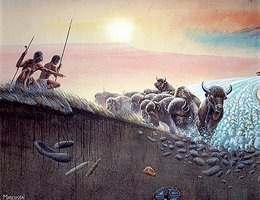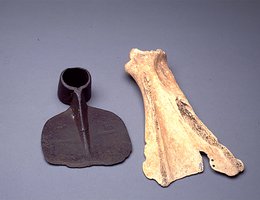
Image

Image by Mark Marcuson, courtesy University of Nebraska State Museum, Nebraska Game and Parks Commisssion GP-PAL003-KB0004_02
Image

Courtesy Nebraskaland Magazine, Nebraska Game and Parks, BUFF06 BG0002+01
Image

Courtesy Nebraska Game and Parks Commission, GP-ARCH02_KB0016_02
Web Page
The change in the Nebraska landscape was dramatic. In just a few short years, cattle replaced the American bison as the leading, cloven-hoofed, grass-eating mammal on the Great Plains. In 1850, millions of bison ranged the grasslands and were the main natural resource for the region’s American Indians.
In 1868, the steel rails of the transcontinental railroad created a barrier that bison did not like to cross. That divided the great herd into northern and southern herds.
When the great trail drives ... Read more
Web Page
The archaeological record in western and central Nebraska suggests that Native American people migrated to the region somewhere around 1675 CE. We think they came from further west and north. Archaeologists have found evidence of these people and named the culture after where the sites were discovered in the 1930s — along the Dismal River in the Nebraska sand hills. Dismal River Cultural sites also have been excavated in the Republican River basin. So, the Dismal River cultural complex occupied ... Read more
Web Page
Plains Indians exhibited great skill and ingenuity in turning the natural materials they found around them into tools and materials to help them survive. They used stones, bones, shells, clay, hides, hair, and wood to make tools and implements. But, one of their greatest natural resources was the bison.
The Native Americans of eastern Nebraska in the late 1600s and early 1700s developed a system of seasonal travel carefully planned to put them at the right place at the right time ... Read more
Web Page
Web Page
The first accepted evidence we have of human beings on the Central Plains is around 12,000 years old. Archaeologists have found spear points near Clovis, New Mexico, and elsewhere that date from that era.There is some evidence that human beings may have lived here even earlier, but that evidence is disputed. Most scientists believe the ancestors of today’s Native Americans walked across a "land bridge" from Asia to ... Read more
Web Page
Web Page
The oldest known Indian tool found in Nebraska is the Clovis point, made about 10,000 B.C.E. It is a spear point with a groove or flute, at its base. Attached to a shaft, this spear point was capable of penetrating an elephant’s hide. The Clovis culture takes its name from the town in New Mexico where the striking stone projectile point characteristic of this culture was first found. The chipped flint points known as Clovis points and a variety of ... Read more
Web Page
The Pawnee was one of the earliest Native American tribes to be described in the European historical record, and they were one of the largest groups to live and roam across the territory. Their name most likely comes from a Pawnee word for horn which was “Pariki” or “Parrico” and was in reference to the way they fashioned their hair to look to have a horn or horns. The French explorers recorded the term as “Pani” as eastern native groups ... Read more
Web Page
Find out where these Protohistoric cultures are.
Around 1600 CE, the first of the Protohistoric tribal cultures to return to the Nebraska region may have been the ancestors of the Pawnee. Several archaeological sites around the present day Lower Loup River in east-central Nebraska have been found, and these sites have named for that river basin.
Precise dates are difficult, but one interpretation of Pawnee stories or oral history says that they immigrated into Nebraska from the south about 1600. Archaeologists also ... Read more
Web Page
The Central Plains Village Tradition period (from 900 -1450 CE) saw a rapid increase in population on the plains and, in one sense, was the culmination of the changes that began during the Plains Woodland period. Archaeologists estimate that there were more people in the region during the period than at any other time before or since. In other words, there were more people living on the plains than there are even now. About 5,000 archaeological sites have been discovered ... Read more
Web Page
Issues related to the environment, use of drugs and chemicals, and other problems shaped not only public policy, but consumer demand. In meeting these challenges, new and expanding niche markets for cattle grew.
Since the first days of cattle in Nebraska, producers have worked to keep up with the wishes of their consumers. Breeding and feeding technologies were developed to produce the tasty meat that Americans and people around the world wanted.
Most cattle in Nebraska belong to the Angus and Hereford ... Read more
Web Page
The Oto tribe gave this state its name, but they were not native to the region. "Nebraska" is an Oto word that means "flat water." Like migrant groups before and after, the Oto immigrated to the Central Plains from the east, just ahead of the Europeans.
The earliest mention of the Oto and Missouria tribes in the European historical record dates from the late 1600s. The Missouria were then in central Missouri and the Oto were in central Iowa. The Otos ... Read more
Web Page
1600 CE was a pivotal time in the history of Nebraska,and there are at least two compelling stories to tell.